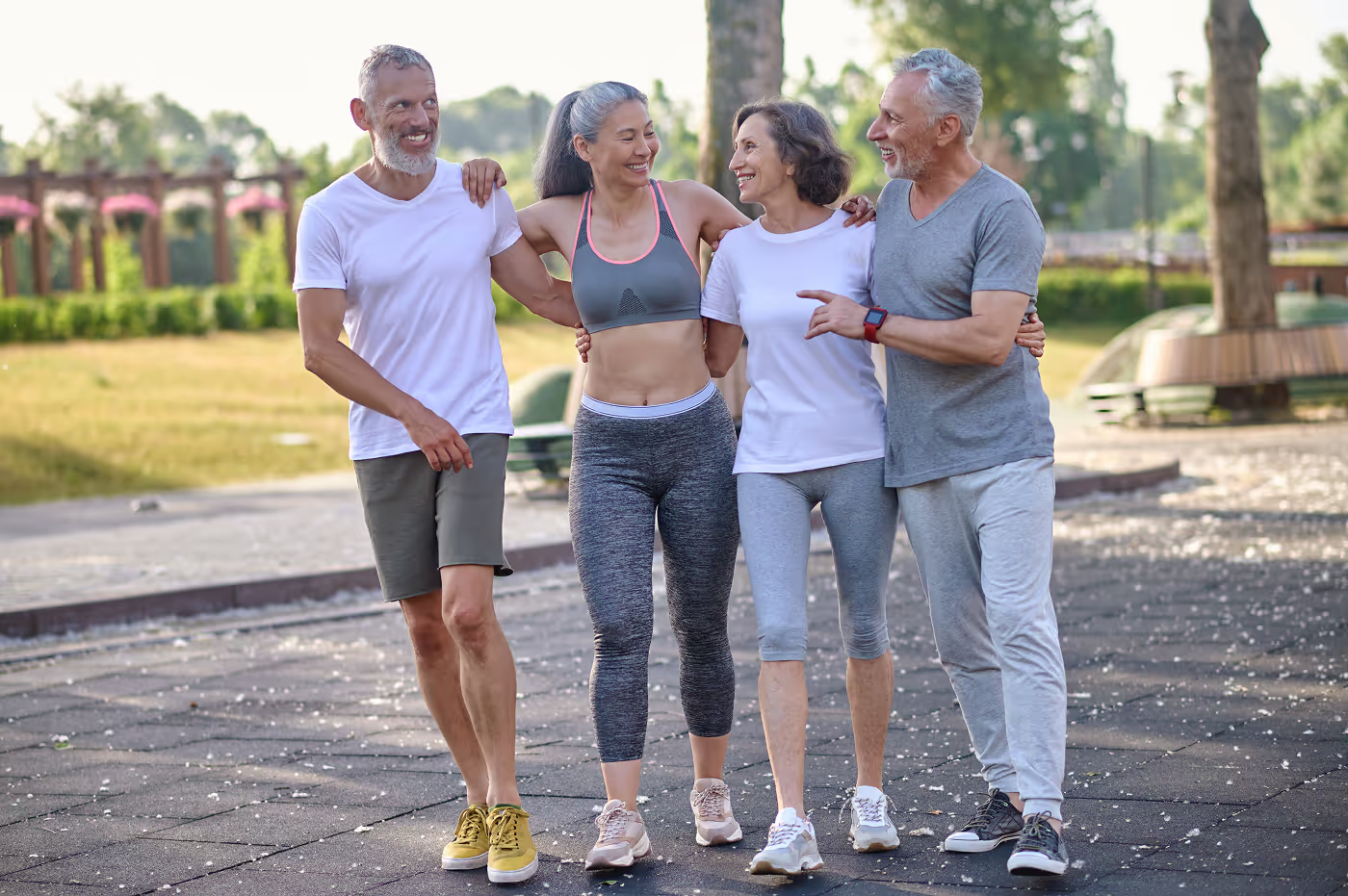
You’ve probably seen it, someone in their 60s hiking mountains while someone in their 30s struggles to get off the couch. What’s their secret? It’s not luck. It’s healthspan.
Everyone wants to live longer. But what’s the point of adding years if they’re not good years?
The real game-changer isn’t lifespan — it’s how well you live during those years.
From fitness to medicine, the focus has shifted from “how many birthdays can I collect?” to “how strong, sharp, and active can I stay at 60, 70, 80, or beyond?”
This isn’t about chasing eternal youth. It’s about designing a life that ages well where you can still hike mountains, lift weights, laugh hard, and remember where you left your keys.
Let’s break down what truly keeps your body younger for longer and how you can start today.
Healthspan vs. Lifespan — The Real Difference
Lifespan is how long you live.
Healthspan is how long you live well.
You can live to 90 and spend your last 20 years managing medications and joint pain or live to 85 still strong, independent, and full of energy.
Key players in this process include:
- Cellular senescence: aging cells that stop dividing but don’t die, releasing inflammatory signals that damage tissues.
- Mitochondrial slowdown: your cells’ energy plants weaken, leading to fatigue and slower recovery.
- Epigenetic changes: your biological age (how old your body acts) diverges from your actual (chronological) age.
A 2023 study from Harvard’s Sinclair Lab found that resetting epigenetic marks in mice reversed aging markers across multiple organs. In simple terms: aging isn’t just a countdown, it's a programmable process.
These aren’t just cool lab findings. They prove that lifestyle choices today literally rewrite the code for how you age tomorrow.
Key Shift: Don’t chase anti-aging, chase pro-function.
How to Design Your Longevity Plan — Fitness That Ages With You
What’s the best anti-aging “drug”? Exercise and it’s free!
But longevity training isn’t about pushing harder. It’s about training smarter for decades.
Here’s the science-backed combo for healthspan training:
1. Strength Training (2–4× per week)
- Goal: Preserve muscle, bone density, and insulin sensitivity.
- Sample exercises: Squats, deadlifts, push-ups, pull-ups, bench press, and rows.
- Duration: 45–60 minutes per session.
- Study: Research from the British Journal of Sports Medicine (2022) found that strength training just 1–2×/week lowers all-cause mortality by up to 20%.
Tip: Focus on compound lifts, progressive overload, and perfect form.
“Strength = longevity currency.”
2. Zone 2 Cardio (3–5× per week)
- Goal: Boost mitochondrial efficiency and fat metabolism.
- Intensity: You should be able to hold a conversation but not sing (60–70% of max heart rate).
- Sample exercises: Brisk walking, easy cycling, rowing, swimming, incline treadmill, or hiking.
- Duration: 30–60 minutes per session.
Tip: Think “long and steady,” not “hard and fast.” This builds endurance you’ll still have in your 70s.
3. High-Intensity Intervals (HIIT) (1–2× per week)
- Goal: Improve VO₂ max — one of the strongest biomarkers of longevity.
- Sample formats: 20 seconds sprint + 40 seconds rest × 10 rounds; or 4×4-minute efforts at 85–90% max HR with equal recovery.
- Duration: 20–30 minutes total including rest.
Tip: Keep it “short and intense”. Overdoing HIIT can backfire on recovery and hormones.
4. Mobility & Balance Work (Daily or 3–5× per week)
- Goal: Maintain joint health, posture, and coordination.
- Sample exercises: Dynamic stretching, yoga flows, hip openers, thoracic rotations, and single-leg balance drills.
- Duration: 10–20 minutes.
Tip: Move your joints through full range daily. “Flexibility now prevents fragility later.”
Key Shift:
Each type of movement feeds a different system — strength for power, cardio for energy, mobility for freedom. Together, they build a body that lasts.
Nutrition for Longevity — Fuel, Don’t Fight Your Body
Eating for longevity isn’t about restriction, it’s about supporting repair and resilience.
Focus on:
- Protein — The Foundation (1.6–2.0g/kg body weight daily)
Protein is your body’s repair crew. It preserves lean muscle, supports hormones, and keeps your metabolism running strong. Think of protein as the raw material for your “cellular renovation.”
You’ll find it in:
Eggs, chicken, turkey, lean beef, fish, tofu, lentils, Greek yogurt, cottage cheese, and whey or plant-based protein powders.
- Polyphenols & antioxidants — The Cell Protectors
These compounds fight oxidative stress — the daily wear-and-tear that accelerates aging.
The brighter the color, the higher the antioxidant power.
Load up on:
Berries (blueberries, raspberries, strawberries), olive oil, green tea, dark chocolate (85%+ cacao), turmeric, and colorful veggies like spinach, kale, and beets.
- Omega-3 fats — The Inflammation Fighters
Omega-3s are essential for brain health, joint protection, and reducing inflammation — one of the key drivers of aging. If you rarely eat fish, consider a high-quality fish oil or algae-based omega-3 supplement.
Top sources include:
Fatty fish (salmon, sardines, mackerel), walnuts, flaxseeds, chia seeds, and omega-3 fortified eggs.
- Fiber & fermented foods — The Gut Guardians
About 70% of your immune system lives in your gut, so taking care of it means taking care of your long-term health. A healthy gut microbiome helps reduce inflammation, stabilize mood, and even regulate metabolism.
Get your fiber from:
Oats, quinoa, legumes, apples, avocados, sweet potatoes, and leafy greens.
And feed your gut bacteria with:
Yogurt, kefir, sauerkraut, kimchi, miso, and kombucha.
Emerging science:
Intermittent fasting and time-restricted eating trigger autophagy — your body’s built-in “clean-up” mode that removes damaged cells.
But longevity isn’t one-size-fits-all. For some, skipping meals improves energy and focus; for others, it backfires.
Key Shift: Eat to rebuild, not restrict. Longevity nutrition fuels cellular strength, not starvation.
Biomarkers & Biological Age — Tracking the Inside Story
Forget counting birthdays. Start tracking how well your body’s systems actually perform.
Top biomarkers to monitor:
- VO₂ max → cardiovascular fitness
- HRV (Heart Rate Variability) → recovery & stress balance
- Fasting glucose & insulin → metabolic health
- hs-CRP → inflammation marker
- Grip strength → predictor of all-cause mortality
- DEXA or InBody scans → muscle vs. fat ratio
- Epigenetic clocks: Companies like TruDiagnostic or InsideTracker measure your biological age through DNA methylation.
Two people can both be 45, but one’s body could function like 35 — or 55 — depending on daily habits.
Key Shift: Don’t chase youth, measure progress. Data helps you catch small declines before they become health setbacks.
The Big 4 Lifestyle Levers of Longevity
Longevity isn’t built in a lab, it’s lived every day. These four pillars outlast any supplement or trend:
- Sleep — Your nightly repair mode.
Deep sleep boosts growth hormone, immune function, and cognitive resilience. - Stress — Manage the load.
Chronic cortisol shortens telomeres (the “caps” on DNA that protect your cells). (Blackburn et al., PNAS, 2015) - Social connection — The overlooked superpower.
Loneliness increases mortality risk as much as smoking 15 cigarettes per day (Holt-Lunstad, 2015). - Purpose — The reason you get up.
People with strong life purpose live up to 7 years longer (JAMA Network, 2019).
So it isn't just from one perfect habit, it’s from the compound interest of daily choices.
Key Shift: Long life isn’t found in the gym, it’s maintained through how you rest, relate, and recharge.
Mental Fitness & Cognitive Longevity — Train Your Brain Like a Muscle
Muscles aren’t the only things that weaken with age — the brain does too, unless you train it.
Just like your body, your brain thrives on challenge, novelty, and use.
Neuroscience confirms it: learning new skills, facing new challenges, and staying socially and creatively engaged all strengthen neural connections — literally helping your brain age slower.
Science Insight:
A long-term study from the Journal of Neuroscience (Park et al., 2014) found that older adults who learned complex new skills — like digital photography and computer design — significantly improved memory and cognitive flexibility.
Another study in Frontiers in Aging Neuroscience (2018) linked lifelong learning and creativity to increased neuroplasticity — the brain’s ability to rewire and stay resilient with age.
Or as neuroscientist Dr. Wendy Suzuki puts it:
The best thing you can do for your brain is to keep learning, moving, and connecting. The brain loves novelty — it’s what keeps it young.
Practical Ways to Keep Your Brain Sharp:
1. Learn a new language
Boosts memory, focus, and emotional processing. Try short daily sessions with Apps like Duolingo, Language Transfer, platforms like italki or chat with a native speaker online.
2. Pick up an instrument (or a new genre)
Strengthens coordination and pattern recognition. Even 10 minutes of practice activates multiple brain regions.
3. Play strategy or coordination games
Choose chess, table tennis, or rhythm games — they sharpen timing, focus, and quick decision-making.
4. Travel differently
New environments wake up your brain’s memory and curiosity centers. Take a new route or explore unfamiliar places nearby.
5. Cook something new — from scratch
Following recipes challenges sequencing, attention, and creativity. Try a dish from a culture you’ve never cooked before.
6. Combine body + brain
Dance, martial arts, climbing, or yoga build coordination and mental focus — movement strengthens cognition.
7. Learn a skill outside your comfort zone
Coding, photography, or design push your brain to adapt and form new neural pathways.
8. Change your routine on purpose
Use your non-dominant hand, rearrange your workspace, or take a different route. Small changes keep the brain flexible.
Your brain needs challenges the way your muscles need weights.
Key Shift:
Longevity isn’t just about how long your body lasts — it’s how long your mind stays curious, adaptable, and alive.
Challenge it, surprise it, and it will keep rewarding you with clarity, creativity, and resilience for decades.
A creative mind ages slower — because it never stops growing.
Final Thoughts
Longevity isn’t about hacking time, it's about respecting it.
You don’t need endless supplements or fancy biohacks to age well.
You just need consistent strength, good sleep, nourishing food, low stress, and a purpose that pulls you forward.
The goal isn’t to live forever. It’s to live better, for longer.
So, ask yourself:
If you met your 80-year-old self today, would he/ she thank you for how you’re living now?





















